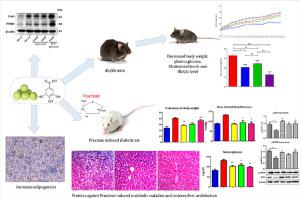Phytomedicine ( IF 6.7 ) Pub Date : 2019-04-01 , DOI: 10.1016/j.phymed.2019.152906 Bhavesh C Variya 1 , Anita K Bakrania 1 , Snehal S Patel 1

|
Background
Nature has gifted a variety of vital phytochemicals having potential therapeutic application against various ailments. Emblica officinalis (E. officinalis), an ancient plant, has long been used as a remedy for diabetes and cardiovascular complications, and presence of abundant amount of gallic acid could be accountable for its medicinal potential.
Purpose
The study was aimed to determine the in-vivo and in-vitro anti-diabetic potential of gallic acid and fruit juice of E. officinalis. Molecular mechanism of gallic acid as well as fruit juice of E. officinalis for anti-diabetic potential has also been revealed.
Experimental study design
Anti-diabetic potential of E. officinalis and gallic acid was evaluated in 3T3-L1 preadipocytes and various animal models like db/db mice and fructose administered rats. PPAR-γ expression and glucose translocation were observed using western blot and PCR techniques.
Results
Treatment of E. officinalis fruit juice and gallic acid facilitated their glucose homeostasis; improved insulin sensitivity; reduced obesity; abridged elevated blood pressure and declined cholesterol level, and also induced adipogenesis in 3T3-L1 adipocytes. Mechanistically, treatment increased expression of PPAR-γ through activation of C/EBPs and simultaneously increased Glut4 translocation in 3T3-L1 adipocytes. Moreover, gallic acid treatment increased insulin sensitivity through activation of Akt rather than AMPK signaling pathway while fruit juice of E. officinalis showed dual activation, Akt and AMPK as well.
Conclusion
These findings reveal the role of gallic acid in E. officinalis mediated antidiabetic potential, and delineate the upregulation of pAkt, PPAR-γ and Glut4 in gallic acid mediated antidiabetic activity, thus providing potential therapy for diabetes and related disorders.
中文翻译:

余甘子中没食子酸的抗糖尿病潜力:通过PPAR-γ和Akt信号传导改善葡萄糖转运蛋白和胰岛素敏感性。
背景
大自然赐予了多种重要的植物化学物质,它们对各种疾病都有潜在的治疗应用。余甘子(E. officinalis)是一种古老的植物,长期以来一直被用作糖尿病和心血管并发症的治疗方法,大量的没食子酸的存在可能是其潜在的医学用途。
目的
本研究旨在确定在体内和体外没食子酸和果汁的抗糖尿病潜在E.巴戟。没食子酸的分子机制,以及果汁E.厚朴的抗糖尿病的潜力也已经显现出来。
实验研究设计
在3T3-L1前脂肪细胞和各种动物模型(例如db / db小鼠和果糖给药的大鼠)中评估了厚朴叶肠杆菌和没食子酸的抗糖尿病潜力。使用蛋白质印迹和PCR技术观察到PPAR-γ表达和葡萄糖易位。
结果
的治疗E.巴戟果汁和没食子酸促进他们的葡萄糖体内平衡; 改善胰岛素敏感性;减少肥胖;减少了高血压,降低了胆固醇水平,还诱导了3T3-L1脂肪细胞的脂肪生成。从机制上讲,治疗通过激活C / EBPs来增加PPAR-γ的表达,并同时增加3T3-L1脂肪细胞中Glut4的易位。此外,没食子酸处理通过激活Akt而不是AMPK信号传导途径来提高胰岛素敏感性,而厚皮大肠杆菌的果汁也显示出双重激活,Akt和AMPK也是如此。
结论
这些发现揭示了没食子酸在大肠埃希菌介导的抗糖尿病潜力中的作用,并描绘了在没食子酸介导的抗糖尿病活性中pAkt,PPAR-γ和Glut4的上调,从而为糖尿病和相关疾病提供了潜在的治疗方法。











































 京公网安备 11010802027423号
京公网安备 11010802027423号